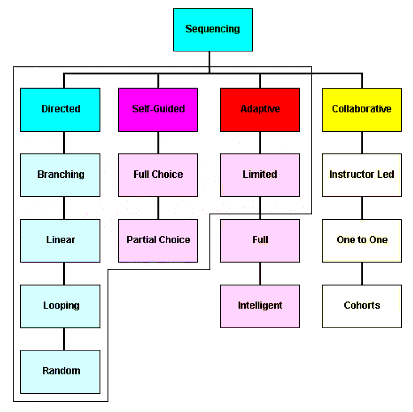IMS Simple Sequencing: Difference between revisions
(using an external editor) |
(using an external editor) |
||
| Line 20: | Line 20: | ||
## IMS Simple Sequencing Best Practice and Implementation Guide - Version 1.0. This document provides an overview and describes how the IMS Simple Sequencing Information Model and XML Binding can be applied to specific types of interoperability scenarios. | ## IMS Simple Sequencing Best Practice and Implementation Guide - Version 1.0. This document provides an overview and describes how the IMS Simple Sequencing Information Model and XML Binding can be applied to specific types of interoperability scenarios. | ||
=== Scope of Simple Sequencing === | === Scope of IMS Simple Sequencing === | ||
According to IMS Best Practice Guide 1.0, the "Simple Sequencing Specification addresses a small but productive segment of the entire problem space for learning content sequencing. The IMS Simple Sequencing Specification relies on the concept of learning activities. A learning activity may be loosely described as an instructional event or events embedded in a content resource, or as an aggregation of activities that eventually resolve to discreet content resources with their contained instructional events." | |||
The IMS definition of a [[learning activity]] is in [[our opinion|User:Dschneider]] related to the concept of [[mastery learning]] or similar instructional designs. According to the best practice guide, " | |||
a ''Learning Activity'' is a pedagogically neutral unit of instruction, knowledge, assessment, etc. It can have sub-activities and may be nested to an arbitrarily deep level. Each activity may have a tracking status associated for each learner that is assigned to experience the activity. Activities can be attempted any number of times, or the number can be specified. They can be suspended, abandoned, exited normally, etc. All activities are performed within the context of a parent activity. | |||
[[image: ims-ss-scope.gif]] | [[image: ims-ss-scope.gif]] | ||
=== The Activity Tree === | |||
By default the SS Specification deines | |||
| Line 35: | Line 47: | ||
* [http://www.imsglobal.org/simplesequencing/index.html Simple Sequencing Specification] | * [http://www.imsglobal.org/simplesequencing/index.html Simple Sequencing Specification] | ||
* [http://www.imsglobal.org/simplesequencing/ssv1p0/imsss_bestv1p0.html IMS Simple Sequencing Best Practice and Implementation Guide - Version 1.0] | |||
[[Category:Educational technologies]] | [[Category:Educational technologies]] | ||
Revision as of 14:15, 10 April 2006
Definition
- Quote "The IMS Simple Sequencing Specification defines a method for representing the intended behavior of an authored learning experience such that any learning technology system (LTS) can sequence discrete learning activities in a consistent way. The specification defines the required behaviors and functionality that conforming systems must implement. It incorporates rules that describe the branching or flow of instruction through content according to the outcomes of a learner's interactions with content. The Specification was released to the public in March 2003." ( [Content Packaging Specification] )
- Simple sequencing implies a fairly classic behaviorist instructional design model.
- However, one also can do less. Some critiques when confronted with e-learning talk about "spray and pray method", shovelware, or "page turning" and that reflect how sometimes e-learning is implemented. However, within a Simple Sequences compatible LMS you can implement designs that do respect some pedagogical standards, e.g. Mastery learning. DSchneider thinks that Simple Sequencing is not that simple and that producing pure shovelware is not an obligation :)
- For a more powerful, but slightly more difficult alternative see IMS Learning Design.
Details
- The IMS Simple Sequencing Specification was developed to allow sequencing descriptions to be embedded within a IMS Content Packaging manifest file using the XML namespace extension set aside for IMS Simple Sequencing. In other words this means that as an author all you need is a tool that fully implements IMS Content Packaging + Simple sequencing extensions. Therefore, see also IMS Content Packaging.
Documentation
- The IMS Simple Sequencing Best Practice and Implementation Guide - Version 1.0 list following components
- IMS Simple Sequencing Information and Behavior Model - Version 1.0. This document describes the data structures that are used to provide interoperability between learning management systems which sequence learning activities;
- IMS Simple Sequencing XML Binding - Version 1.0. This document describes how to encode the sequencing objects in XML and provides the corresponding XML schema;
- IMS Simple Sequencing Best Practice and Implementation Guide - Version 1.0. This document provides an overview and describes how the IMS Simple Sequencing Information Model and XML Binding can be applied to specific types of interoperability scenarios.
Scope of IMS Simple Sequencing
According to IMS Best Practice Guide 1.0, the "Simple Sequencing Specification addresses a small but productive segment of the entire problem space for learning content sequencing. The IMS Simple Sequencing Specification relies on the concept of learning activities. A learning activity may be loosely described as an instructional event or events embedded in a content resource, or as an aggregation of activities that eventually resolve to discreet content resources with their contained instructional events."
The IMS definition of a learning activity is in User:Dschneider related to the concept of mastery learning or similar instructional designs. According to the best practice guide, " a Learning Activity is a pedagogically neutral unit of instruction, knowledge, assessment, etc. It can have sub-activities and may be nested to an arbitrarily deep level. Each activity may have a tracking status associated for each learner that is assigned to experience the activity. Activities can be attempted any number of times, or the number can be specified. They can be suspended, abandoned, exited normally, etc. All activities are performed within the context of a parent activity.
The Activity Tree
By default the SS Specification deines
